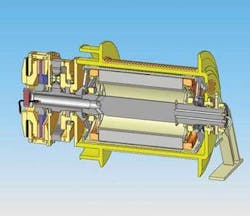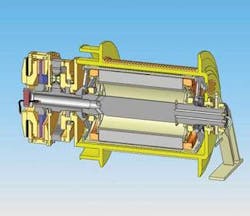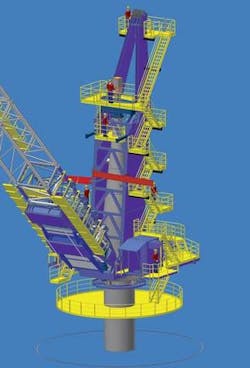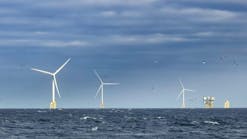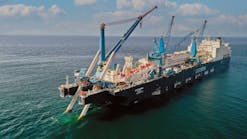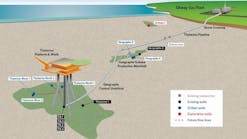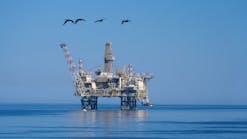National Oilwell Varco (NOV) is developing the company’s latest all-electric king post cranes with AC variable-frequency drive. The cranes currently are in final assembly and testing in Molde, Norway.
Recognized around the world as a leading supplier of high technology driven drilling solutions, NOV also is a leading supplier of cranes and winches through its Lifting and Handling Solutions Group. The group includes such brands as Amclyde, BLM, Hydralift, Molde Crane, and Unit Mariner.
The new king post crane was developed for semisubmersible/drillship rigs that often operate in the harshest offshore marine environments, and is believed to be the first of its kind designed in compliance with both the API 2C 6th Edition and EN 13852-1 crane codes.
Development of this next-generation crane shows how NOV handles complex projects among many of its design locations. The structural and mechanical design was performed in NOV’s St. Paul, Minnesota, location, while the electrical and controls design was done in NOV’s Molde location. Furthermore, NOV’s Product and Service Development Team (PSDT) in Stavanger, Norway, developed the permanent magnet winch motor. The crane will be assembled and tested at the Molde facility.
Bigger loads in rougher seas
Off-board ratings allow this crane to operate in sea states up to 13-ft (4-m) significant wave heights (SWH) on the main hook and 20-ft (6-m) SWH with the auxiliary hook. The main hook is designed to operate off-board with ratings up to 33 metric tons (36 tons) at 66-ft (20-m) radius in a 13-ft (4-m) sea and 109 metric tons (120 tons) in calmer seas up to a 3.28-ft (1-m) SWH. .
To meet the demands of the EN 13852-1 crane code and to afford operation in high sea state environments, NOV has developed a unique winch design. This code calls for an Automatic Overload Protection System (AOPS), which requires a means to release the load automatically in a matter of milliseconds should the crane hook snag during load transfer between the rig or platform and a vessel alongside. The Permanent Magnet Winch (PMW) and its control system are patented by NOV, and use a so-called “inside-out” permanent magnet motor (PM motor) located inside the winch drum. The result is a small, compact winch compared to standard electrical winch designs.
Cutaway section of the Permanent Magnet Winch incorporated into NOV’s new king post crane.
The inside-out PM motor has a stationary shaft, while the outer drum is the rotating part of the motor, in contrast to standard motors, on which the shaft rotates. The permanent magnets are fastened to the inside of the rotor drum, creating a magnetic field, while the electrical windings are in the stationary part. The power cables to the PM motor go through the shaft and into the stator windings, and the torque from the PM motor is transferred via a planetary gearbox into the winch drum.
The PMW used on this crane is designed to fulfill the requirements of both API and EN regulations requiring high torque, high rotation speed, and high accelerations. These requirements are fulfilled without using additional mechanical components on the winch, such as a clutch, since the complete system is designed to have low inertia. The motor’s high output torque affords a low gearbox ratio which, when combined with the low inertia rotor, makes the winch very responsive to emergency overload conditions and forms the basis for the crane’s compliance with EN 13852-1 for AOPS and MOPS (Manual Overload Protection System).
Much improved HSE issues
Health, Safety and Environment (HSE) issues are improved significantly with this PMW design compared with traditional hydraulically operated cranes, and also compared with standard electrically operated cranes. Two independent mechanical braking systems are installed on the PMW, but in addition there is a third braking feature due to use of the PM motor. In case of power loss the PM motor will act as a generator (dynamo) and will produce a dynamic braking torque reflecting the actual load in the hook. This feature also makes emergency lowering much safer. “Free fall situations” are not possible, even if all mechanical brakes are fully open.
The reduced number of components installed on the PMW makes the overall design simple and easy, which again leads to lower maintenance and easier trouble shooting. Also, since the PM motor is located inside the winch drum and is liquid cooled, the noise generated by this winch is extremely low.
The balance of the crane’s electrical system consists of state-of-the-art AC flux vector variable frequency drives (VFD), which provide for high system efficiency and a high power factor to minimize power consumption off the rig power grid. Crane control is accomplished using NOV proven PLC-based crane control software complete with system diagnostics capabilities, which are easily accessed from the operator’s display screen. Each hoist function and each of the swingers is supplied with an independent VFD and each can be reassigned in the event of a drive failure. The control system consists of dual independent PLCs and a communication link to exchange configuration data to the active PLC. The electrical system provides for safe, quiet, clean and environmentally friendly operations as compared to traditional hydraulic systems.
To meet EN code criteria with respect to failure modes, NOV has incorporated a “precise link” into the load path. As the name suggests, the link has a very precise and predictable failure load. The link is sized to minimize weights of critical cabin supporting components while providing adequate threshold for AOPS response time. The link is boom-mounted and a failure due to catastrophic overload confines crane damage locally to the boom’s outer structure.
King post design improvements
The king post design provides the inherent safety features common to this type of crane. The new NOV design addresses several traditional problems of relatively high weight and less-precise swing control as compared to slew bearing cranes. By the use of high-strength materials and aluminum secondary members, weight has been minimized.
Three-dimensional inventor model of crane machinery platform and lower boom mounted on NOV’s newest king post crane.
Swing control has been improved by incorporating hardened steel rollers fitted with anti-friction bearings at the lower radial reaction surface in lieu of the traditional friction wear pads. Unlike the “stick” characteristics found with the traditional wear pad design, the steel rollers provide for smooth rolling and controlled swing start/stops. What’s more, unlike the excessive “wear” found with wear pad design, the hardened steel rollers exhibit minimal wear, allowing preset swinger pinion/ bull gear backlash to be maintained. This eliminates excessive boom tip movement (float).
NOV offers both king post and slew ring all-electric cranes that meet both API and EN codes. The first six of the newly designed king post cranes are scheduled to be delivered in Q3 and Q4 2007.
For more information, contact Dick Juelich at[email protected]
